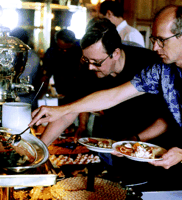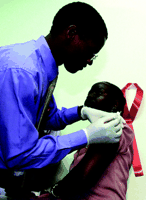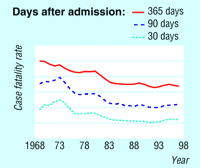This week in the BMJ
Volume 327,
Number 7418,
Issue of 4 Oct 2003
![[Down]](/icons/down.gif) Death rate after fractured neck of femur has stabilised
Death rate after fractured neck of femur has stabilised
![[Down]](/icons/down.gif) Sexual pleasure improves after hysterectomy
Sexual pleasure improves after hysterectomy
![[Down]](/icons/down.gif) Dietary fat is not associated with stroke in men
Dietary fat is not associated with stroke in men
![[Down]](/icons/down.gif) Cluster trials are vulnerable to bias
Cluster trials are vulnerable to bias
![[Down]](/icons/down.gif) Simvastatin should be taken at night
Simvastatin should be taken at night
![[Down]](/icons/down.gif) Global coalition builds research capacity in Africa
Global coalition builds research capacity in Africa
Death rate after fractured neck of femur has stabilised
Deaths after fractured neck of femur declined from the early 1960s to the early 1980s, but not since then. In a time trend analysis for 1968 to 1998, Roberts and Goldacre (p 771) examined case fatality rates at 30, 90, and 365 days after admission for over 30 000 elderly people in southern England with fractured neck of femur. They found that in the first month after fracture standardised mortality ratios in women were 16 times higher, and those in men 12 times higher, than mortality in this age group in the general population. The authors say that it is unclear whether mortality has fallen to an irreducible minimum, or whether further reduction is possible. They highlight the importance of the prevention of osteoporosis, falls, and fractures in elderly people.
![[To top]](/icons/back.gif)
Sexual pleasure improves after hysterectomy
Sexual pleasure improves after hysterectomy, regardless of the surgical technique. Roovers and colleagues (p 774) compared the effects of vaginal hysterectomy, subtotal abdominal hysterectomy, and total abdominal hysterectomy on sexual wellbeing over six months in more than 400 women in the Netherlands. They found that sexual activity did not change after surgery, but general satisfaction about sexuality improved. The authors also report that the three surgical techniques were associated with similar persistence and development of bothersome problems during sexual activity.

| |
Credit: MICHELLE PEDONE/PHOTONICA
|
|
![[To top]](/icons/back.gif)
Dietary fat is not associated with stroke in men
The intake of total fat, cholesterol, or major specific types of fat is not associated with risk of stroke in men. For 14 years He and colleagues (p 777) tracked the diet of and incidence of stroke in 43 732 male US healthcare professionals without a history of cardiovascular diseases or diabetes. They found that—even after adjusting for age, smoking, and other potential confounders—dietary fat was not a strong predictor of stroke in men, contrary to the findings of previous studies. They also found that men with higher consumption of red meat, high fat dairy products, nuts, or eggs did not have a higher risk of stroke. Additional research is needed given the inconsistent literature, say the authors.

| |
Credit: RAY ROBERT/REX
|
|
![[To top]](/icons/back.gif)
Cluster trials are vulnerable to bias
Cluster trials, in which groups of patients rather than individuals are randomised, are vulnerable to bias. Puffer and colleagues (p 785) reviewed a sample of cluster trials published in the BMJ, Lancet, and New England Journal of Medicine over the past five years and found that some trials have methodological weaknesses that could make their results unsound. For example, of the 36 trials studied only 15 described having used a secure method of allocating clusters. The authors state that cluster trials are an important method of evaluating some healthcare interventions and they can be difficult to do; therefore, sources of bias in cluster trials must be recognised and prevented at the planning stage.
![[To top]](/icons/back.gif)
Simvastatin should be taken at night
Simvastatin is best taken at night, when concentrations of total cholesterol and low density lipoprotein may be at their greatest. Wallace and colleagues (p 788) randomised 60 patients who had been taking simvastatin at night to take it either in the morning or at night and compared the change in their blood lipid profiles after eight weeks. Switching to taking simvastatin in the morning significantly increased total cholesterol and low density lipoprotein. Compliance did not differ between the two groups, the authors say.

| |
Credit: COLIN GRAY/PHOTONICA
|
|
![[To top]](/icons/back.gif)
Global coalition builds research capacity in Africa
An innovative global partnership is helping build up medical research in Africa. The Ptolemy project, named after the general who built the great library in Alexandria housing the written corpus of the ancient Mediterranean and Middle Eastern worlds, makes surgeons in East Africa research affiliates to the University of Toronto. Beveridge and colleagues (p 790) describe their development of the project, in which African scholars are granted access to the full-text resources of the university and become members of an electronic research community. Even though Ptolemy is a small project, it has the potential to be widely reproduced, say the authors.

| |
Credit: JEAN-MARC BOUJU/AP
|
|
![[To top]](/icons/back.gif)
Death rate after fractured neck of femur has stabilised
Sexual pleasure improves after hysterectomy
Dietary fat is not associated with stroke in men
Cluster trials are vulnerable to bias
Simvastatin should be taken at night
Global coalition builds research capacity in Africa




